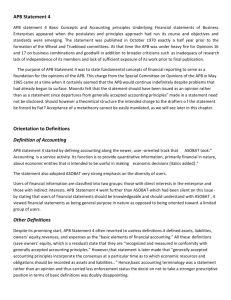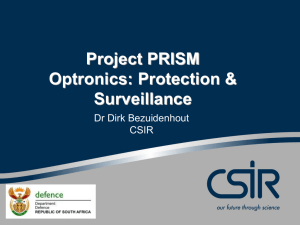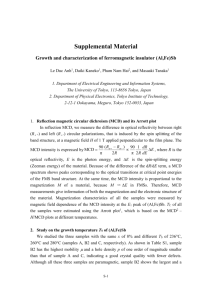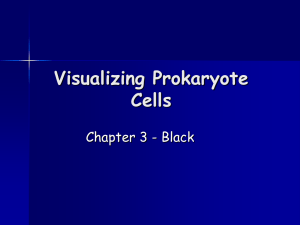Atomic resolved study of defects in GaSb grown on Si
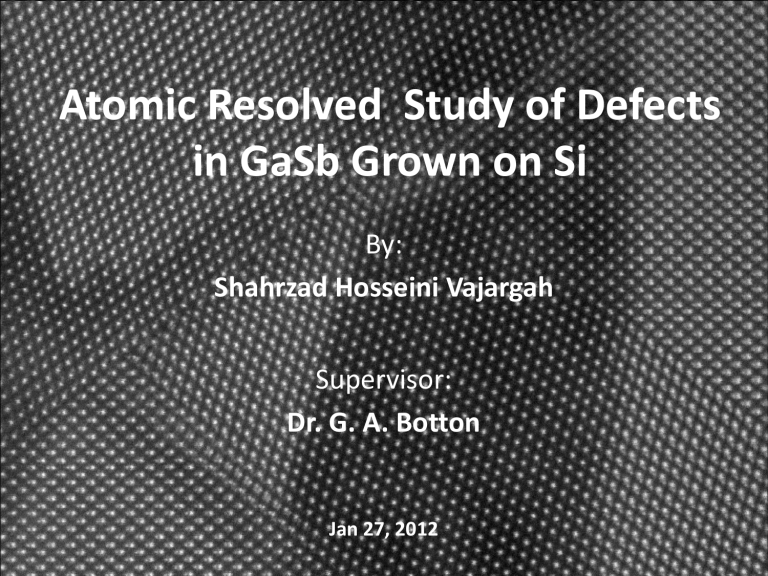
Atomic Resolved Study of Defects in GaSb Grown on Si
By:
Shahrzad Hosseini Vajargah
Supervisor:
Dr. G. A. Botton
Jan 27, 2012
Outline
Introduction
Solar cell & Multijunctions
Physical Properties & Crystal Structure
Growth Techniques & Challenges
Importance of defects and their Identification Techniquces
Characterization Methods and Techniques
Results
Identification of Polarity Reversal and Antiphase Boundaries
Strain Analysis
Summary & Acknowledgment
MATLS 702
2
Solar energy-power from the Sun
• Increasing world consumption of energy
• Fossil fuel shortage
• Global warming
• Need for sustainable development
Photovoltaic Effect
Incident of Photons
Generation of carriers by p-n junction movement of electrons to the n-type side and holes to the p-type side of junction
Generation of voltage
Efficiency: Ratio of number of carriers collected by solar cell to photons of given energy
3
Physical properties & applications
Sb-based Compound Semiconductors
Wide range of bandgap energies from 0.165 eV for InSb to 1.58 eV for
AlSb
AlSb indirect and InSb and GaSb direct bandgap
High electron mobility and wide range of bandgap offsets
Applications:
Multijunction solar cells
High speed electronic devices
Thermophotovolatic applications
MATLS 702
4
Crystal structure
Silicon (Substrate)
Diamond structure
Centrosymmetric
Advantages: low cost, large-scale integration and high quality
GaSb (Film)
Zinc-Blende structure
Non- Centrosymmetric
Wide range of bandgap energies
Advantages: bandgap tunability
5
MATLS 702
Thin film growth technique
Molecular Beam Epitaxy (MBE)
Features
Ultra high vacuum and controlled temperature condition
Effusion cells
Heated substrate
Different deposition ratio
In-situ surface analysis with
Reflection High Energy Electron Diffraction
(RHEED)
Advantages
Abrupt interface
Highly precise controlling of doping levels
MATLS 702
6
Growth challenges
Lattice mismatch between film and substrate
Misfit dislocation
Relaxation of film
Planar Defects
Twins
Anti-Phase Boundaries (APB)
Polar on non-polar growth
Stoichiometric and non-Stoichiometric
Lowest formation energy {110}-type APB
(Vanderbilt et al. 1992, Rubel et al. 2009)
7
D. Cohen and C. B. Carter, Journal of Microscopy, 208 (2), 84 –99 (2002).
Why are defects so important?
• Uncompleted or dangling bonds in the core of dislocations generate states near the middle of bandgap which are deep levels acting as recombination centers.
• Elastic strain field of defects changes atomic distances and hence electronic states, acting as a trap.
• Antiphase boundaries create non-radiative recombination centers.
Reduction of efficiency of solar cell
8
APBs’ identification techniques with TEM
-200 200
200-type Superlattice Reflections
Gowers, J. P. (1984). Applied Physics A Solids and
Surfaces, 34(4), 231-236.
• Two beam Condition Dark Field Imaging
S. Y. Woo(2012) et al. (Submitted)
Convergent Beam Electron Diffraction
(CBED)
MATLS 702
A. Beyer, I. Ne ´ meth, S. Liebich, J. Ohlmann, W. Stolz, and K. Volz, J. of Appl. Phys. 109,
083529 (2011)
9
APBs’ identification techniques with TEM
High Resolution Transmission Electron
Microscopy (HRTEM) images cannot be interpreted directly.
Defocus
MATLS 702
Simulations show that the contrast highly depends on imaging condition
APB with twin
S. H. Huang, G. Balakrishnan, A. Khoshakhlagh, L. R. Dawson, and D. L.
Huffaker, Appl. Phys. Lett. 93, 071102 (2008).
V. Narayanan, S. Mahajan , K.J. Bachmann, V. Woods, N. Dietz, Acta Materialia 50 1275 –1287 (2002)
10
Research objectives
To understand:
the atomic arrangements at antiphase boundaries
origin of the APB at interface
possible mechanism of APBs’ self-annihilation
In order to:
prevent the APB formation, or
make them to self-annihilate
MATLS 702
11
High Angle Annular Dark Field-STEM
Transmission Electron Microscopy
Z-contrast (High angle annular dark field –
HAADF) Scanning Transmission Electron
Microscopy (STEM)
High angle elastically scattered electrons
Annular detector
Composition sensitive
Less sensitive to thickness and focus
Resolution is limited by lens aberrations:
1-Spherical (Cs)
2-Chromatic (Cc)
Advantages of using Aberration correctors:
Better Resolution
Reduced Contrast Delocalization
Sub-Å probe for spectroscopy
Tuning capability of Cs
MATLS 702
12
Strained-layer superlattice (SLS)
SLS
Structure of the Epilayers
Layers
Active Layer
Thickness and Composition
1000 nm GaSb
25 × 10 nm GaSb
25 × 10 nm AlSb
GaSb Layer
Buffer Layer
Substrate
1 μm GaSb
5 nm AlSb
Si (001) Flat
GaSb AlSb
(a)Experimental HAADF-STEM Image
(b) Multisclice Simulation of GaSb
(c) Multisclice Simulation of AlSb
13
MATLS 702
Polarity reversal Top views
MATLS 702
Side view
14
Edge-on APB twin
APB
GaSb
Si
Mixed
Nucleation
MATLS 702
15
Strain measurement technique
Geometric Phase Analysis (GPA)
In an image of perfect crystal intensity at each position like (r) can be written as Fourier sum which has amplitude and phase component.
Degree of contrast of a set of fringe Lateral position fringes within image
(Geometric phase)
For a perfect crystal: Phase is constant across image
For an imperfect crystal: Any lattice distortion or displacement causes local shift of fringes and consequently phase change or phase shift.
Phase variations Local displacement field Strain Matrix
MATLS 702
16
Strain distribution twin
APB y x
MATLS 702
17
Summary
• Polarity reversal due to the formation of antiphase boundaries has identified directly for the first time with HAADF-STEM.
• The direct identification of polarity reversal with HAADF-STEM avoids the misinterpretations in characterizing the planar defects.
• The APB has formed due to the mixed nucleation at interface in spite of prior soaking with Sb.
• Different bonding length in anti-phase bonds compared to in-phase bonds induces strain and lattice rotation at APB.
• Compensating the lattice rotation by lateral shift and faceting can play an important role in the self-annihilation of the APBs.
• Simultaneous control of the substrate misorientation angle and prelayer soaking step in growth can help to suppress the APB formation.
18
MATLS 702
Acknowledgment
• My supervisor: Prof. G. A. Botton
• Research Group Fellows for helpful suggestions
• Canadian Centre for Electron Microscopy
(CCEM) staff
• Ontario Center of Excellence (OCE)
• Center of Emerging Device Technology for providing me with samples
• Arise Technology for funding this project
19
Thank you !
Questions?
20
